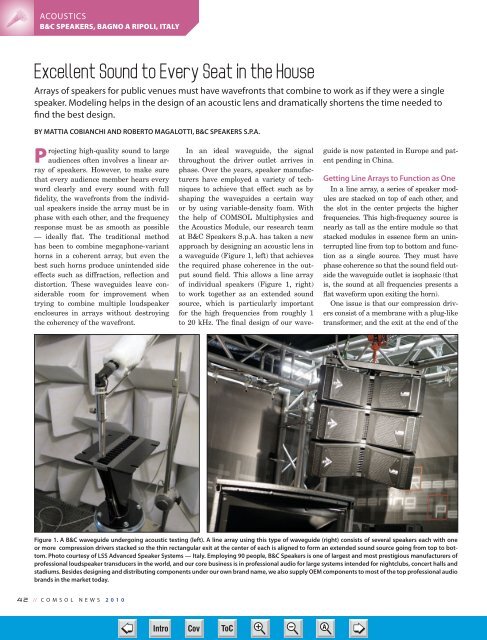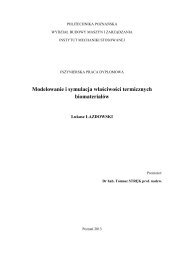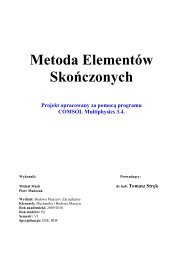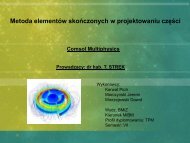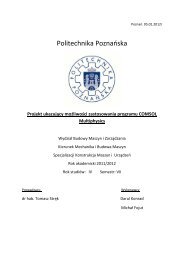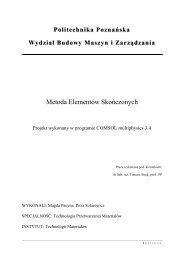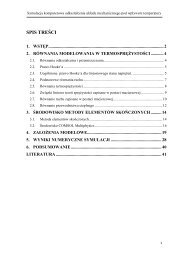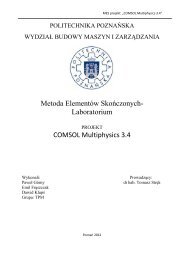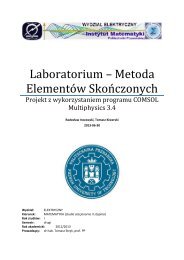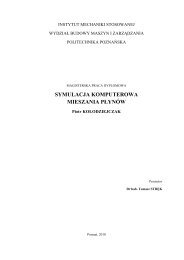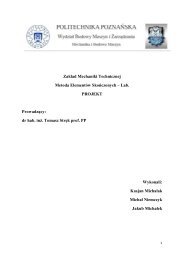comsol - tomasz strek home page
comsol - tomasz strek home page
comsol - tomasz strek home page
You also want an ePaper? Increase the reach of your titles
YUMPU automatically turns print PDFs into web optimized ePapers that Google loves.
ACOUSTICS<br />
B&C SPEAKERS, BAGNO A RIPOLI, ITALY<br />
<br />
Arrays of speakers for public venues must have wavefronts that combine to work as if they were a single<br />
speaker. Modeling helps in the design of an acoustic lens and dramatically shortens the time needed to<br />
find the best design.<br />
BY MATTIA COBIANCHI AND ROBERTO MAGALOTTI, B&C SPEAKERS S.P.A.<br />
Projecting high-quality sound to large<br />
audiences often involves a linear array<br />
of speakers. However, to make sure<br />
that every audience member hears every<br />
word clearly and every sound with full<br />
fidelity, the wavefronts from the individual<br />
speakers inside the array must be in<br />
phase with each other, and the frequency<br />
response must be as smooth as possible<br />
— ideally flat. The traditional method<br />
has been to combine megaphone-variant<br />
horns in a coherent array, but even the<br />
best such horns produce unintended side<br />
effects such as diffraction, reflection and<br />
distortion. These waveguides leave considerable<br />
room for improvement when<br />
trying to combine multiple loudspeaker<br />
enclosures in arrays without destroying<br />
the coherency of the wavefront.<br />
In an ideal waveguide, the signal<br />
throughout the driver outlet arrives in<br />
phase. Over the years, speaker manufacturers<br />
have employed a variety of techniques<br />
to achieve that effect such as by<br />
shaping the waveguides a certain way<br />
or by using variable-density foam. With<br />
the help of COMSOL Multiphysics and<br />
the Acoustics Module, our research team<br />
at B&C Speakers S.p.A. has taken a new<br />
approach by designing an acoustic lens in<br />
a waveguide (Figure 1, left) that achieves<br />
the required phase coherence in the output<br />
sound field. This allows a line array<br />
of individual speakers (Figure 1, right)<br />
to work together as an extended sound<br />
source, which is particularly important<br />
for the high frequencies from roughly 1<br />
to 20 kHz. The final design of our waveguide<br />
is now patented in Europe and patent<br />
pending in China.<br />
Getting Line Arrays to Function as One<br />
In a line array, a series of speaker modules<br />
are stacked on top of each other, and<br />
the slot in the center projects the higher<br />
frequencies. This high-frequency source is<br />
nearly as tall as the entire module so that<br />
stacked modules in essence form an uninterrupted<br />
line from top to bottom and function<br />
as a single source. They must have<br />
phase coherence so that the sound field outside<br />
the waveguide outlet is isophasic (that<br />
is, the sound at all frequencies presents a<br />
flat waveform upon exiting the horn).<br />
One issue is that our compression drivers<br />
consist of a membrane with a plug-like<br />
transformer, and the exit at the end of the<br />
Figure 1. A B&C waveguide undergoing acoustic testing (left). A line array using this type of waveguide (right) consists of several speakers each with one<br />
or more compression drivers stacked so the thin rectangular exit at the center of each is aligned to form an extended sound source going from top to bottom.<br />
Photo courtesy of LSS Advanced Speaker Systems — Italy. Employing 90 people, B&C Speakers is one of largest and most prestigious manufacturers of<br />
professional loudspeaker transducers in the world, and our core business is in professional audio for large systems intended for nightclubs, concert halls and<br />
stadiums. Besides designing and distributing components under our own brand name, we also supply OEM components to most of the top professional audio<br />
brands in the market today.<br />
// COMSOL NEWS 2010<br />
➮<br />
Intro<br />
Cov ToC + – A<br />
➭


